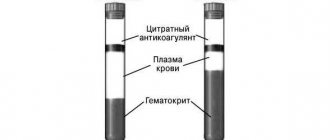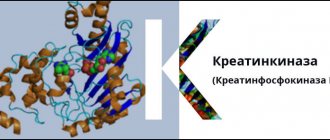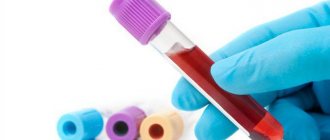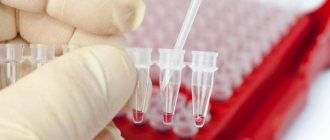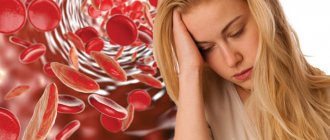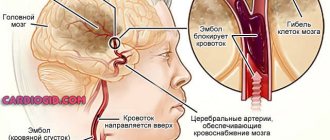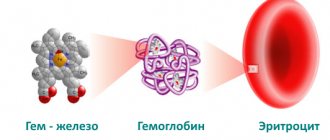Blood biochemistry
07/16/201801/25/2019 Yulia Martynovich (Peshkova) 2280 Views creatinine
In this article we will look at the reasons why creatinine in the blood is low. Creatinine, or a nitrogenous metabolite, is involved in providing muscle tissue with energy. It is the end product of the breakdown of creatine phosphate. Filtered by the glomeruli without reabsorption.
A high level of the substance indicates a decrease in the filtration activity of the kidneys. Low creatinine levels in the blood are a rare phenomenon, but not without diagnostic significance. You should understand the causes and methods of treating this condition.
The study is carried out using the Jaffe kinetic method. The time frame for receiving results is 1-2 days. Cost from 150 rub.
- 1 When is the analysis carried out?
- 2 Creatinine: children’s and adult indicators
- 3 What are the causes of low creatinine in the blood? 3.1 Physiological causes of decreased creatinine levels
Role and functions
Creatinine is the main indicator of kidney activity. Determining its concentration as a component of blood fluid is necessary to assess the rate of protein metabolism in the human body. In addition, this value shows how quickly creatinine is excreted by the kidneys.
When proteins and amino acids are broken down, the body releases byproducts, not the least of which is creatinine. Creatine is found in muscle mass and helps provide it with the energy it needs to function properly.
In most cases, this substance is eliminated during:
- digestion of food in the duodenum and stomach;
- physical effort.
When the protein is broken down, the enzyme travels from the bloodstream to the kidneys, where it is filtered and excreted in the urine.
The amount of creatinine in blood fluid indicates the rate of protein breakdown. A reduced concentration of this substance may indicate the development of many pathological processes in the early stages of formation. This breakdown product negatively affects muscle function.
Creatinine is a product of the non-enzymatic breakdown of creatine and creatine phosphate, which is formed in muscles. It is excreted from the body by the kidneys.
Synonyms Russian
1-methylglycocyamidine, a product of the conversion of creatine phosphate, creatinine in the blood.
English synonyms
Creatinine, Creat, Serum Creat, Cre, Blood creatinine, Serum creatinine, Urine creatinine.
Research method
Kinetic method (Jaffe method).
Units
μmol/L (micromoles per liter).
What biomaterial can be used for research?
Venous, capillary blood.
How to properly prepare for research?
- Do not eat for 12 hours before the test.
- Avoid physical and emotional stress 30 minutes before the test.
- Do not smoke for 30 minutes before the test.
General information about the study
Creatinine is a residual product produced in muscles when a substance called creatine is broken down. Creatine is part of a cycle that provides the body with energy to contract muscles. After 7 seconds of intense physical activity, creatine phosphate is converted to creatine, which then turns into creatinine, which is filtered in the kidneys and excreted in the urine. Creatine and creatinine are stably produced by our body in constant quantities. Almost all creatinine is excreted by the kidneys, so its concentration in the blood is a good indicator of kidney function. The amount of creatinine produced depends on total body weight and, in particular, muscle mass. Therefore, for example, creatinine levels in men will be significantly higher than in women and children.
A small part of it (15%) is secreted by the tubules, but it is mainly produced due to filtration in the glomeruli. The level of creatinine in the blood does not go beyond the normal range until glomerular filtration rate decreases to critical values, especially in patients with low muscle mass. The creatinine level then rises.
It is precisely because of the large number of components (muscle mass, gender, age) that affect the concentration of creatinine in the blood that this study is not the best screening test for detecting renal failure. At the same time, creatinine is a more sensitive indicator of kidney disease than urea.
What is the research used for?
- To assess renal function.
- To assess the function of major organs and systems (in combination with other studies).
- To evaluate kidney dysfunction and the effectiveness of its treatment if creatinine or urea are outside the normal range and the patient has an underlying chronic disease, such as diabetes, that affects the kidneys.
- If the level of creatinine in the blood and urine is known, the creatinine clearance (Rehberg test) can be calculated - this test shows how effectively the kidneys filter small molecules such as creatinine from the blood.
- To calculate the glomerular filtration rate to confirm kidney damage.
When is the study scheduled?
- At certain intervals in case of already known kidney disease or a disease that can cause deterioration of kidney function (together with a test for urea and microalbuminuria).
- When diagnosing skeletal muscle diseases.
- Before and after the hemodialysis procedure.
- For symptoms of kidney dysfunction: weakness, fatigue, decreased attention, poor appetite, sleep problems,
- swelling of the face, wrists, ankles, ascites,
- foamy, red or coffee-colored urine
- decreased diuresis,
- problems with urination: burning, intermittency, change in frequency (predominance of nocturnal diuresis),
- pain in the lumbar region (especially on the sides of the spine), under the ribs,
- high pressure.
What do the results mean?
Reference values (creatinine norm):
Creatinine
| Age, gender | Reference values | |
| 21 - 75 µmol/l | ||
| 1 - 12 months | 15 – 37 µmol/l | |
| 1 – 3 years | 21 - 36 µmol/l | |
| 35 years | 27 - 42 µmol/l | |
| 5 – 7 years | 28 - 52 µmol/l | |
| 7 - 9 years | 35 - 53 µmol/l | |
| 9 – 11 years | 34 - 65 µmol/l | |
| 11 – 13 years | 46 - 70 µmol/l | |
| 13 – 15 years | 50 – 77 µmol/l | |
| > 15 years | male | 62 - 106 µmol/l |
| > 15 years | female | 44 - 80 µmol/l |
GFR (glomerular filtration rate): 60 and above.
Causes of increased creatinine levels
- Acute and chronic renal failure (amyloidosis, kidney damage due to diabetes, etc.).
- Failure of the cardiovascular system (myocardial infarction, cardiogenic shock, myocardial dystrophy, etc.).
- Massive destruction of muscle tissue (crash syndrome) and release of creatinine from cells.
- Burns (massive necrosis of cells with the release of their contents into the intercellular substance).
- Acromegaly.
- Gigantism.
- Hyperthyroidism.
- Dehydration (blood thickening and relative hypercreatininemia).
- Excessive physical activity.
- Excessive consumption of meat products.
- Radiation sickness.
- Obstruction of the urinary tract.
- Taking nephrotoxic drugs (mercury compounds, sulfonamides, thiazides, aminoglycoside antibiotics, cephalosporins and tetracycline, barbiturates, salicylates, androgens, cimetidine, trimethoprim-sulfamethoxazole).
- Damage to the blood vessels of the glomerular apparatus of the kidneys (glomerulonephritis), which may be a consequence of an infectious or autoimmune disease.
- Bacterial kidney infection (pyelonephritis).
- Necrosis of the tubular epithelium (acute tubular necrosis), caused, for example, by drugs or toxins.
- Prostate disease, nephrolithiasis or other factors causing obstruction of the urinary system.
- Reduced blood flow to the kidneys due to shock, dehydration, acute heart failure, atherosclerosis, or complications of diabetes.
Reasons for decreased creatinine levels
- Starvation.
- Overhydration (blood dilution – relative hypocreatininemia).
- Amyotrophy.
What can influence the result?
- Factors distorting the result Pregnancy (especially the first and second trimesters).
- Excess muscle mass, such as in some athletes (possibly elevated creatinine levels despite normal kidney function).
Norm
The final blood content is expressed as a constant value. If a decrease in value is observed, this indicates some pathologies associated with hormonal imbalances, changes in weight or diet.
As a rule, creatinine levels in women are always underestimated compared to those in men. This is due to different muscle mass.
Normal values for women are presented in the table below.
Normal value, µmol/l
The male half of the population has the following values:
Normal value, µmol/l
Ways to increase creatinine levels
At the first stage, a person is recommended to choose a special diet that will contain a high amount of muscle fibers. Consumption of meat, fish and other seafood is increasing. There is no complete alternative to the diet, so vegetarians should add at least fish dishes to the menu to maintain health.
In general, building muscle mass leads to a natural increase in the indicator to normal values. This is facilitated by:
- rational nutrition and physical activity;
- drinking water at least 2 liters per day;
- vitamins and mineral complexes, if necessary, to restore the lack of these substances.
Energy reserves are replenished by regulating sleep patterns. Prolonged lack of rest, exhaustion and fatigue contribute to the development of chronic depression and decreased performance. Against this background, the biochemical composition of the blood also changes. You should plan the amount of work for each day in such a way that you have at least 6 to 7 hours of sleep left.
Separately, we should highlight the situation when the concentration of creatinine falls against the background of diseases. In this case, an extended differential diagnosis is carried out, a final diagnosis is established and treatment is selected.
Symptoms of decreased levels
Clinical symptoms characteristic of low creatinine levels will depend on the condition of the human body. The pathological process may be accompanied by:
- intestinal dysfunction, manifested by indigestion or stomach upsets;
- pain and heaviness in the right hypochondrium;
- decreased physical activity;
- and lack of strength without reason;
- pain in the heart muscle.
It is necessary to check the concentration of this enzyme after injuries, nervous exhaustion and in the postpartum period.
Functions of creatine in the body
Creatine (2-ethanoic acid), which is found in human muscles and urine. Thanks to scientific research, its beneficial effect on the development of muscle mass and increasing body strength has been proven.
The mechanism of action of creatine is simple: the kidneys and pancreas produce this substance from 2 essential and 1 essential amino acids. This is enough for the normal operation of all systems, but in order for the process not to fail, a person’s diet must contain food rich in protein.
The produced creatine with blood ions enters the skeletal muscles, brain, heart and other organs that need it. According to the established norm, the human body contains about 150 g of this substance. Costs per day are approximately 2 g, but with high physical activity they increase. The excess is removed as part of the compound.
However, if it is present in pure form in urine, it signals health problems. Thus, creatinine stimulates the most important biochemical and physiological processes in the body, ensuring normal motor activity and the functioning of all systems.
The biological functions of creatine are:
- active participation in the creation of creatine phosphate, which restores ATP levels during periods of increased physical activity;
- assistance in transporting the energy of ATP molecules to the system that needs it;
- is a nutrient for the nervous system and brain. Improves signal transmission from neuron to neuron;
- release of anaerobic energy with possible oxygen starvation;
- reducing the likelihood of depression;
- stimulation of myocardial function and removal of cholesterol from blood vessels, which is a sign of the onset of vascular atherosclerosis;
- reduction of symptoms during inflammatory processes (arthritis);
- stimulating muscle growth, preventing the development of the process of their breakdown;
- normalizing the acid-base balance;
- combating acidification of body systems;
- neutralizing the effects of lactic acid produced during heavy physical activity;
- helping to increase the quality and length of life.
Factors contributing to the decline
This condition, in which the indicator may be below normal, is recognized relatively rarely. This may depend on age or pregnancy. However, experts identify many common causes of low creatinine levels. These include:
- treatment with drugs from the group of corticosteroids;
- heart failure;
- following a vegetarian diet or following a strict diet;
- liver disease (cirrhosis);
- rapid loss of muscle mass;
- muscle injuries;
- pathologies of infectious origin, characterized by impaired renal blood flow;
- malignant tumors;
- severe dehydration of the human body;
- antidiuretic deficiency.
The reasons for the decrease in the content of this substance in the fair sex may be as follows:
- strict adherence to the diet;
- lack of meat in the diet;
- underweight;
- childbirth;
- use of glucocorticosteroids.
In men, creatinine falls as a result of:
- liver disease;
- severe renal impairment;
- cancer;
- heart failure;
- decreased muscle mass;
- shock;
- cirrhosis of the liver;
- following a protein-free diet.
In addition, age, sedentary lifestyle and use of muscle stimulants have a significant impact on enzyme concentrations.
To determine the exact cause of the deviation from the norm, it is necessary to conduct additional diagnostic studies.
When is the analysis performed?
The referral is issued by a general practitioner, nephrologist, infectious disease specialist, gynecologist or endocrinologist. Indications for analysis:
- signs of disease of the urinary system: change in the color of urine, difficulty urinating, pain or cramping, persistently high blood pressure, pain in the lumbar region, swelling, insomnia, weakness and poor appetite;
- the need for hemodialysis and evaluation of its effectiveness;
- control over the effectiveness of treatment methods for kidney pathologies;
- identification of complications when taking nephrotoxic drugs;
- advanced diagnostics of skeletal muscle diseases;
- severe dehydration of the body;
- preparatory procedures before computed tomography.
Venous blood is collected for the study.
When is the study ordered?
A biochemical blood test is recommended for the development of:
- sepsis (infection of the cerebrospinal fluid);
- renal failure;
- chronic high blood pressure (hypertension);
- state of shock.
In addition, before dialysis, it is necessary to undergo a procedure (blood purification for diagnosing kidney failure) and collect kidney samples.
Determination of creatinine levels is also necessary when a patient is admitted to the intensive care unit or intensive care unit.
3.How to measure creatinine clearance?
Glomerular filtration rate reflects the functioning of the kidneys. If the kidneys begin to function poorly, then creatinine clearance also decreases.
There are two main ways that doctors use creatinine to measure kidney function:
- Daily urine analysis, in which all the urine in one day is collected in a special container;
- Glomerular filtration rate can be measured using a one-time blood test, the results of which are inserted into a special formula for calculation.
Blood tests are used much more often because... it is more convenient.
How is diagnostics carried out?
To get the most reliable result, you need to properly prepare for the procedure. To do this, experts recommend following a few simple recommendations:
- avoid increased physical activity for a few days;
- the day before the session, refrain from eating large amounts of protein foods (a maximum of 200 grams of meat or fish is allowed);
- Avoid smoking and drinking alcohol;
- drink a lot of clean water.
If the patient is taking any medications, this should be reported to the attending physician. The specialist may recommend temporarily stopping the drug or take this factor into account when interpreting the data obtained.
Blood, serum, or urine can be used to test the enzyme concentration in the blood fluid. It is recommended to carry out the procedure in the morning on an empty stomach.
The sample is taken from a vein.
Urinalysis is a little more difficult to perform because it relies on measurements of the average daily value and clearance. The latter is based on the ability of the kidneys to clear creatinine from the blood.
In this case, urine collection is required throughout the day. The liquid is then sent in small quantities to a laboratory for testing.
It is also important that the urine container is clean and sterile. Collection begins after waking up, but the first urine is skipped.
A dark, cool place is used to store collected urine. It is important not to neglect the rules of hygiene. If dirt or foreign liquid gets into the container, you are more likely to get skewed results.
Only a specialist should interpret this information.
It is important to consider the patient's general condition, age and gender, physical activity and other factors that may affect creatinine levels.
Preparing and conducting analysis
Before taking the tests, you must follow the following recommendations:
- 2 days before the due date, reduce physical activity to a minimum.
- For a week, do not drink alcoholic beverages, strong coffee and tea, as well as meat and foods with a high protein content.
- The last meal should be taken 10 hours before this test.
- Before the diagnosis, get a good night's sleep and try not to be nervous.
- Stop taking medications and smoking.
Simultaneously with the biochemical examination, a urine and blood test is performed. This will allow you to get a more complete picture of deviations from the norm.
Some features should also be taken into account:
- prescribe examinations for women taking into account the days of the menstrual cycle;
- Do not draw blood during physiotherapeutic procedures, ultrasound, or x-rays.
Value Normalization Methods
The choice of therapeutic measures will depend on the factor that caused the decrease in enzyme concentration. In most cases, the main solution to the problem is to increase muscle mass.
Drug therapy
If the cause of the development of the pathology is any disease, then, based on diagnostic studies, the specialist will prescribe appropriate treatment with drugs. Only after the underlying disease is eliminated, the creatinine level will gradually return to normal.
Diet
In the absence of pathologies, first of all it is necessary to reconsider the diet. However, it should be borne in mind that the diet is not associated with the treatment of any serious disease (gout, pancreatitis, etc.).
It is recommended to include more high-protein foods in your daily menu.
Be sure to include in your diet foods such as:
- river and sea fish;
- meat products;
- nuts;
- seafood.
In some situations, when it is necessary to increase the enzyme level in a short time, the attending physician may advise taking special vitamin complexes, which in this case contain all the necessary microelements and substances.
ethnoscience
To normalize these indicators, patients often turn to folk remedies that help increase the level of creatinine in the blood fluid. It should be remembered that such treatment is possible only after consultation with a doctor.
What are the causes of low creatinine in the blood?
The causes of low creatinine in the blood can be divided into female and common to both sexes.
Ladies should pay special attention to this indicator during pregnancy. Because while carrying a baby, the urinary system works in an enhanced mode. There is an increased excretion of a nitrogenous metabolite in the urine. In parallel with this, there is an increase in the total volume of blood in the woman’s body.
Important: low creatine in the blood of women during pregnancy is a variant of the physiological norm (especially in the first and second trimester).
If a woman experiences poor weight gain, she is advised to reconsider her diet and menu. This is of particular importance for ladies who adhere to a vegetarian diet.
For men involved in sports, low creatinine levels are not typical. Especially when using various doping additives, which contain the end product of creatine phosphate decomposition. They are usually characterized by a state of excess amount of the substance in the blood.
Creatinine in the blood is reduced if a person is hungry or lacks fluid in the body. Among the common reasons, the following should also be highlighted:
- severe weight loss and decrease in the percentage of muscle tissue;
- long-term protein-free diet;
- use of glucocorticosteroids;
- myodystrophy.
Separately, the situation should be identified when creatinine is reduced as a result of taking medications. Among them: antibacterial agents, diuretics, sedatives, sleeping pills and steroid drugs. While taking these medications, the patient may receive false-negative laboratory test results. After completing the course of treatment, the test should be repeated 5 to 7 days later to confirm normal creatinine levels in the blood.
Read further: What does an increase in creatinine in the blood of an adult indicate?
Physiological reasons for decreased creatinine levels
It has been noted that creatinine is reduced in people who have been without physical activity for a long time. For example, if it is necessary to comply with bed rest. In this case, the muscles do not require a large amount of energy. The breakdown reaction of creatine phosphate decreases and the amount of creatinine decreases proportionally.
This deviation is temporary. The indicator returns to normal levels when the normal level of physical activity is restored.
A similar situation is typical for older people. Along with a decrease in physical activity, the percentage of muscle tissue in the body decreases. What should be taken into account when identifying the severity of diseases of the urinary system for older people.
Possible complications
In most cases, a decrease in the amount of substances is not accompanied by the development of serious consequences and is a normal reaction to exposure to certain factors. But when the level drops due to the development of the disease, some kind of treatment is required.
A low blood creatinine concentration may or may not indicate a pathological process.
To determine the exact provoking cause, consultation with a specialist doctor is necessary. If the condition is not due to disease, values can be normalized as soon as possible by changing diet and lifestyle.
What is creatinine?
Creatinine is one of the metabolites of biochemical reactions of amino acid-protein metabolism in the body. The formation of this compound occurs constantly and is associated with metabolic processes in muscle tissue. Since muscles constitute one of the main masses of the human body, and contraction requires a constant energy substrate, powerful energy carriers must be embedded in their structure. This is necessary in order to meet emergency energy needs.
The main donor of ATP for muscle tissue is creatine phosphate - the phosphorylated essential amino acid creatine. After synthesis in the liver, it enters the muscles, where it is dephosphorylated by the enzyme creatine phosphokinase. The result of these processes is the formation of energy and creatinine. ATP is used by the muscles to meet energy needs, and the kidneys excrete creatinine in the urine after filtration.
Creatinine, as the final product of breakdown reactions, is not consumed in the body for other metabolic processes. This is a compound that is harmful to tissues and should be eliminated from the body as much as possible. Violation of creatinine metabolism can occur at the stages of its intake, metabolism and excretion!
